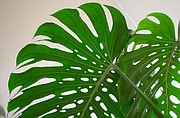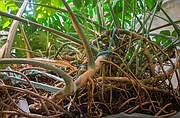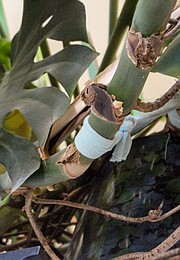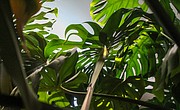One serious plant: Monstera plants are behemoths, but not too hard to maintain
Plenty of Columbia Basin plant lovers take advantage of the plentiful sunlight in the area, not only filling their yards and gardens with thriving flowers, plants and veggies, but inside their home, too. There’s a wide variety of houseplants popular nowadays, from tiny succulents and cacti to the sheerly “monstrous” ones.
Monstera plants are native to tropical rainforests in Central and South America, but are a popular houseplant that is quite resilient and low-maintenance. The Monstera’s climbing roots will grow up and out, spilling over the container or planter and reaching up to 20 meters high in the wild.
Eric and Karen Lindberg of Moses Lake bought their Monstera houseplant when they moved into their home about 17 years ago. The plant was only about a foot and half tall and wide and sat beside the sink on the countertop.
“It must have really liked it here because it kept getting bigger and bigger,” Eric Lindberg said. “I had to repot it and repot it again. It ended up on the dining room table before it took up the whole dining room table. Then, I was able to move it over my laundry room on a little landing under a skylight.”
Above the laundry room, the Monstera has remained for the past six years, continuing to grow and fill up the space. Lindberg said the landing is about 9-by-12 feet and their Monstera takes up pretty much the entirety of that spot.
After replanting the monstera a few times, Lindberg said the houseplant is currently in a custom-built planter he made.
“The planter is only about a foot deep, it’s about a 4-by-5 box that it’s sitting in,” Lindberg said. “The roots are kind of stringy; they come off the branches and dangle and they’ll kind of search for where the water is at.”
As the new roots come off, Lindberg said he’ll redirect them back down toward the soil. Despite the sheer size of his Monstera plant, Lindberg said it has been surprisingly easy to maintain.
He said he waters the plant once a week along with the rest of their houseplants, but the Monstera does take quite a bit of water. Other than that, he said he will just add some Miracle-Gro houseplant fertilizer once a month. Even as the plant has grown from a countertop decoration to the current-day behemoth, Lindberg said the Monstera remained a relatively easy plant to care for.
Since the Monstera has been above the laundry room under the skylight, Lindberg said he has had some limbs grow upward toward the skylight and fall off into the hallway below. As it’s needed, he said he will chop off some parts of the plant if the limbs are getting too large, but that doesn’t seem to slow the Monstera down much.
The Monstera is not named for its monstrous size, but for the strange leaves the plant is known for with “Monstera” meaning “strange” in Latin. Nicknamed the “Swiss cheese plant,” the hole-filled leaves of the Monstera help the plants in their natural tropical habitat mitigate rain and wind by allowing them to simply blow right through.
The Monstera’s leaves can be mildly toxic for children and pets, so it is best kept up out of reach in the home. Lindberg said he’s had no issues with bugs with the large Monstera, but he has to comb through and remove built up dust and cobwebs from time to time.
Eric Lindberg said he’s not sure he could relocate the Monstera from its current perch above the laundry room due to its sheer size.
For anyone interested in seeing how big a Monstera plant can grow, Lindberg recommends starting out with a larger pot with space to grow.











